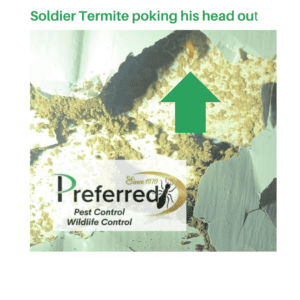Identifying Subterranean Termite Infestations: Essential Signs Homeowners Must Know
Subterranean termites are among the most damaging pests to homes, capable of causing extensive structural damage before they are even detected. Understanding the signs of a subterranean termite infestation is crucial for homeowners to prevent significant damage and financial loss. This blog post outlines the key indicators of subterranean termite activity in your home, providing essential knowledge for early detection and intervention.
Key Signs of Subterranean Termite Infestations
Mud Tubes: These are one of the most definitive signs of subterranean termites. These pencil-sized tubes are constructed from soil and termite saliva and serve as protective tunnels for termites to travel between their underground colonies and food sources above ground. Check your home’s foundation, crawl spaces, and walls for these telltale tubes.
Swarmers: The appearance of termite swarmers, or reproductive termites, inside your home often signifies an existing infestation. These winged termites emerge to mate and start new colonies. While seeing them outside is not always a cause for alarm, finding swarmers indoors is a strong indication of an infestation.
Discarded Wings: After swarmers mate, they shed their wings. Finding piles of discarded wings near windowsills, doors, or other entry points can indicate that termites are entering your home to establish a new colony.
Wood Damage: Subterranean termites consume wood from the inside out, leaving behind a honeycomb pattern in the wood. This damage may not be visible on the surface. Tapping on wood that sounds hollow or feels soft when prodded with a screwdriver can reveal hidden termite activity.
Frass: Unlike other types of termites, subterranean termites do not leave visible droppings known as frass. However, the presence of mud-like droppings or soil within wood or along walls can indicate their activity, as they use soil to construct their mud tubes and nests.
Tight Fitting Doors and Windows: The moisture from termite nests can cause wood to warp, making doors and windows difficult to open or close. This warping can sometimes be mistaken for water damage.
Preventative Measures
Reduce moisture around your home: Subterranean termites are attracted to moisture. Ensure proper drainage away from your home’s foundation and fix any leaking pipes or faucets.
Regular Inspections: Consider annual inspections by a professional pest control service to identify and treat potential termite activity before it becomes a full-blown infestation.
Remove Food Sources: Keep firewood, mulch, and paper away from the foundation of your home. These materials can attract termites and provide them with a food source.
Taking Action
If you notice any of the signs mentioned above, it is critical to act swiftly. Contact a professional pest control service specializing in termite eradication. They can assess the extent of the infestation and recommend an appropriate treatment plan, which may include soil treatments, bait systems, or direct wood treatments to eliminate the colony and protect your home from future infestations.
Conclusion
Subterranean termites pose a serious threat to your home’s structural integrity. By familiarizing yourself with the signs of an infestation, you can take early action to mitigate damage. Regular inspections and preventative measures play a vital role in keeping your home termite-free. Remember, the key to controlling subterranean termite infestations is early detection and professional intervention.
By understanding and acting upon these signs, homeowners can protect their properties from the silent but significant threat posed by subterranean termites. Stay vigilant and proactive in your termite prevention efforts to ensure your home remains safe and secure.


